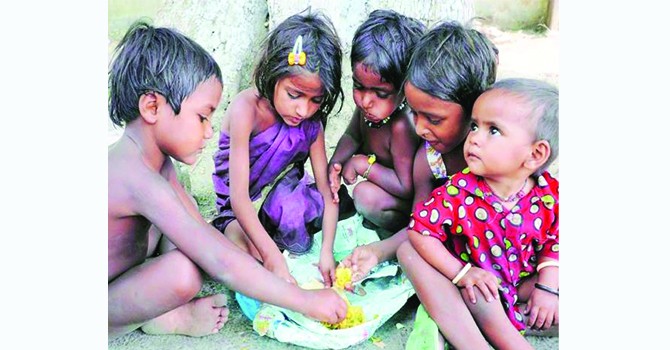Nepal’s hunger status satisfactory in South Asia

By A Staff Reporter
Kathmandu, Dec. 6: The Global Hunger Index (GHI) 2019 has concluded that Nepal has 'Serious Hunger' status with 20.8 point in severity scale.
A global study of the Welthungerhilfe and Concern Worldwide has ranked Nepal in the 73 position among 117 countries. According to the study, score from 0 to 9.9 is considered as low hunger, 10 to19.9 moderate, 20 to 34.9 serious, 35 to 49.9 alarming and above 50 extremely alarming.
Nepal's situation is rather satisfactory as it has slightly crossed the threshold of moderate scale that has 19.9 points ceiling, said Dr. Balaram Thapa, Executive Director of Local Initiatives for Biodiversity, Research and Development (Li-Bird) Nepal, which partnered with the Welthungerhilfe in launching the report here on Thursday.
The report was officially launched in October in Germany, and Nepal special results were announced in the capital on the occasion. Member of the National Planning Commission (NPC) Dr. Krishna Prasad Oli launched the report in Nepal.
In South Asia, Nepal's position is better than Bangladesh, Pakistan, India and Afghanistan and worse than Sri Lanka while Bhutan and the Maldives are not included in the study. China is ranked at 25 and India 102 positions.
Nepal was ranked at 72 in the previous study, though the study is not comparable to the previous years, Nepal's situation in the past year was not degraded rather other countries have also improved their situation.
According to the report, Nepal's score in 2000 was 36.8 which went down to 31.3 in 2005 and 24.5 in 2010.
Likewise, Nepal has made a significant improvement in the areas of proportion of undernourished in population with the proportion coming down to 8.7 per cent in 2018 from 22 from 2001. Similarly, prevalence of wasting in children under five year is 9.6 per cent now which was 11.3 per cent in 2001, prevalence of stunting in children under five years has come down to 36 per cent from 57.1 per cent in 2001 and under-five mortality fell to 3.4 per cent from 8.2 per cent then.
The GHI has used the up-to-date data available for each of the GHI indicators, meaning that the scores are only as current as the data. For the calculation of the 2019 scores, undernourishment data are from 2016-18, child stunting and child wasting data are from 2014-18, with the most current data from that range used for each country, and child mortality data form 2017, said Fraser Patterson, Policy Advisor of Welthungerhilfe.
The index has used data from various United Nations and other multilateral agencies. Undernourishment data came from the Food and Agriculture Organisation (FAO), child mortality data from UN Interagency Group for Child Mortality Estimation (UNIGME), child wasting and child stunting data from the joint database of UNICEF, World Health Organization and the World Bank.
The report stated that for some countries, high scores are driven by high rates of undernourishment, reflecting a lack of calories for large swathes of the population.
For others, high scores result from high levels of child wasting, reflecting acute under-nutrition, child stunting, reflecting chronic under-nutrition, and/or child mortality, reflecting children's hunger and nutrition levels, as well as other extreme challenges facing the population.
Patterson said that at the subnational level in Nepal Karnali State has high level of stunting.
He also said that climate change might impact food production and availability, access, quality, utilisation, and stability of food system which might reinforce the existing gender inequalities as well.
Deputy Regional Director for Asia and Latin America of Welthungerhilfe Anja Schroeder said that the organisation was focusing on the impacts of climate change on hunger.
"The report has shown progress in terms of reducing hunger globally. Conflict and climate change have created risks to the vulnerable communities in the countries in the south," she said.
About 95 million people were affected by climate change related incidents globally and their food consumption was affected.
According to Schroeder, the index was launched to initiate new partnership and dialogue with different actors like government, private sector, civil society and the media.
Recent News

Do not make expressions casting dout on election: EC
14 Apr, 2022
CM Bhatta says may New Year 2079 BS inspire positive thinking
14 Apr, 2022
Three new cases, 44 recoveries in 24 hours
14 Apr, 2022
689 climbers of 84 teams so far acquire permits for climbing various peaks this spring season
14 Apr, 2022
How the rising cost of living crisis is impacting Nepal
14 Apr, 2022
US military confirms an interstellar meteor collided with Earth
14 Apr, 2022
Valneva Covid vaccine approved for use in UK
14 Apr, 2022
Chair Prachanda highlights need of unity among Maoist, Communist forces
14 Apr, 2022
Ranbir Kapoor and Alia Bhatt: Bollywood toasts star couple on wedding
14 Apr, 2022
President Bhandari confers decorations (Photo Feature)
14 Apr, 2022











